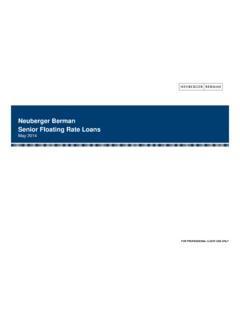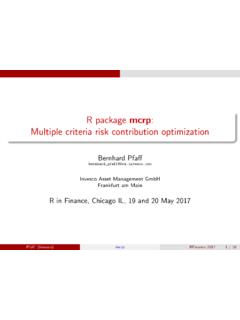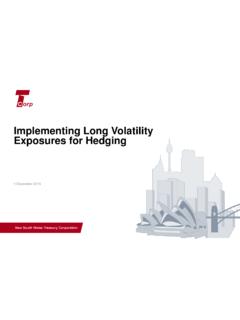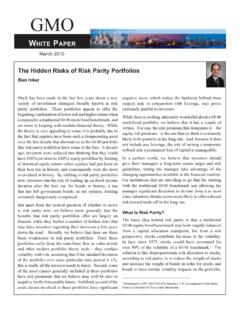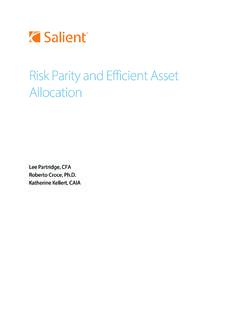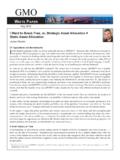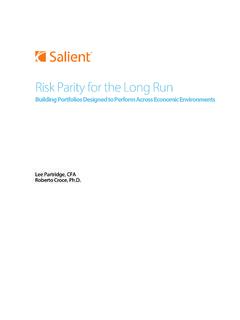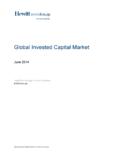Transcription of Keys To Asset Allocation - PAPERS
1 keys To Asset Allocation Wai Lee, PhD Chief Investment Officer & Director of Research Quantitative Investment Group May 25, 2011 Presentation to the PAPERS Spring 2011 Forum NB Quantitative Investment Group We put our work to practice Demystifying Risk- parity Neuberger Berman white paper , forthcoming Risk Budgeting With Asset Class and Risk Class Neuberger Berman white paper , forthcoming Risk-Based Asset Allocation : A New Answer To An Old Question? Forthcoming in The Journal Of Portfolio Management Implementable Tail Risk Management and Optimization Forthcoming in Journal of Derivatives and Hedge Funds Regimes: Non-Parametric Identification and Forecasting The Journal of Portfolio Management, Winter 2010 The Black-Litterman Model For Active Portfolio Management Winner of Bernstein Fabozzi/Jacobs Levy Award for Outstanding Article.
2 Published in The Journal of Portfolio Management, Winter 2009 Risk Budgeting Handbook of Finance: Investment Management and Financial Management, 2008 Implementing Optimal Risk Budgeting The Journal of Portfolio Management, Fall 2001 Modeling and Forecasting Interest Rate Volatility with GARCH Advances in Fixed Income Valuation Modeling & Risk Management1997 Theory and Methodology of Tactical Asset Allocation Wai Lee, 2000. Selected Publications 1 Challenges of Traditional Asset Allocation Asset Allocation Drawing Board The Goal: Maximize Return Penalty for Risk Subject to Constraints Three key elements: Return Risk (and Risk Aversion) Constraints Balancing act between returns and risks 2 The Equation And The Picture The Step-By-Step Guide from textbook NijijiNjNiiiRRCovwwREw111, maxE[R] GMV Tangent Portfolio GMV: Global Minimum Variance Portfolio 3 Economics of Matrix Algebra Lee (2000): Equations ( ), ( ), ( ), ( ) The optimal portfolio is the sum of three component portfolios: ( ): Optimal = GMV + Strategic + Tactical GMV: Global Minimum Variance Portfolio Strategic.
3 Determined by the risk-adjusted equilibrium (long-term) returns of all assets Tactical: determined by the risk-adjusted deviations from equilibrium (long-term) returns of all assets Lee, Wai, Theory and Methodology of Tactical Asset Allocation , 2000, John Wiley & Sons, New York, NY 4 -40%-30%-20%-10%0%10%20%30%40%50%60%Jan- 85 Jan-87 Jan-89 Jan-91 Jan-93 Jan-95 Jan-97 Jan-99 Jan-01 Jan-03 Jan-05 Jan-07 Jan-09-10%-8%-6%-4%-2%0%2%4%6%8%Jan-85 Jan-87 Jan-89 Jan-91 Jan-93 Jan-95 Jan-97 Jan-99 Jan-01 Jan-03 Jan-05 Jan-07 Jan-09-8%-6%-4%-2%0%2%4%6%8%10%Jan-85 Jan-87 Jan-89 Jan-91 Jan-93 Jan-95 Jan-97 Jan-99 Jan-01 Jan-03 Jan-05 Jan-07 Jan-09-25%-20%-15%-10%-5%0%5%10%15%Jan-8 5 Jan-87 Jan-89 Jan-91 Jan-93 Jan-95 Jan-97 Jan-99 Jan-01 Jan-03 Jan-05 Jan-07 Jan-09 Challenge #1.
4 Return Forecasts What are historical equilibrium? And Future? Stocks (Excess Returns) Bonds (Excess Returns) Investment Grade (Excess Returns) Crude Oil (Excess Returns) 5 Challenge #2: Risk Forecasts1 Work Harder Merton (1990): the more frequently we sample the data, the more precise the estimates of volatilities and correlations will be. Risk Return Profile Between 2007 and VolatilityAnnualized Average ReturnTbillStocksTIPSGov BondsCorp BondsCrude OilRisk Return Profile Between 1998 and VolatilityAnnualized Average ReturnTbillStocksTIPSGov BondsCorp BondsCrude OilRisk Return Profile Between 2001 and VolatilityAnnualized Average ReturnTbillStocksTIPSGov BondsCorp BondsCrude OilRisk Return Profile Between 2004 and VolatilityAnnualized Average ReturnTbillStocksTIPSGov BondsCorp BondsCrude Oil_____ , Robert C.
5 , Continuous-Time Finance (1990, Chapter 3) 6 Challenge #3: Constraints Constraints such as no leverage and/or no shorting can lead to risk concentration Optimal portfolio with leverage and short Plan s Required Return Optimal portfolio without leverage or shorting 60/40 Portfolio Frontier with leverage and shorting allowed Return Risk Portfolio Frontier with no leverage, no short A 60/40 of stocks/bonds would be optimal in an unconstrained world if Sharpe ratio of stocks is 3-5 times as high as Sharpe ratio of bonds Optimal portfolio without leverage or shorting 20/80 7 Note and Considerations -20%0%20%40%60%80%100%120%140%Aug-27 Aug-30 Aug-33 Aug-36 Aug-39 Aug-42 Aug-45 Aug-48 Aug-51 Aug-54 Aug-57 Aug-60 Aug-63 Aug-66 Aug-69 Aug-72 Aug-75 Aug-78 Aug-81 Aug-84 Aug-87 Aug-90 Aug-93 Aug-96 Aug-99 Aug-02 Aug-05 Aug-08 StockBondVolatility of 60/40 Note 1: Risk Concentration Of 60/40 No leverage, no shorts, required return Percentage Contribution to Risk and Volatility of 60/40 _____.
6 Neuberger Berman Quantitative Investment Group 8 JGB, 43%Eurobond, 25%UK Bond, 22%Aust Bond, 21%Canada Bond, 23%Dev Equity, 17%EM Equity, 5%Global TIPS, 61%US Bond, 18%Energy, 3%Industrial Metals, 3%Precious Metals, 4%Agriculture, 5%0%30%60%90%120%150%StocksBondsReal AssetsInflowsNB Dynamic Beta Navigator Portfolio Weights (hypothetical weights) Stocks 22% Bonds 151% Real Assets 77% Is Risk parity A Solution? 1 Need leverage to deliver required return _____ (2011): risk- parity is optimal when Sharpe ratios and correlations of all assets are identical 9 Note 2: Stock/Bond Correlation 60/40 today is very different from 20 years ago _____ : Neuberger Berman Quantitative Investment Group 10 Overweight and Underweight, Still?
7 Hypothetical investment views: Hypothetical tactical trades: Or is there a better way to reflect our views? StockBondExp 1: Correlation = - 2: Correlation = + Trades 1 Tactical Trades 1 StockBondExp AlphaExp TEStockBondExp AlphaExp TE5%-5% Trades 2 Tactical Trades 2 StockBondExp AlphaExp TEStockBondExp AlphaExp TE4%15% : Hedge Fund Version No Leverage: Traditional Overlay 11 Note 3: Investment Views Once upon a time, there lived 3 strategists, FX, FI, and EQ .. FX: We expect the rebound of stocks to continue, we are bearish on USD .. FI: We expect the rebound of stocks to continue, lowering the flee-to-safety demands of bonds, ..we are bearish on bonds .." EQ: We expect treasury yield to stay in a range, or even go down a bit as the current real yield seems to be attractive, providing support for equities.
8 " 12 What Are We Forecasting? May add value if can predict future realizations of X; AND the contemporaneous correlation (positive or negative) between X and Y, as hypothesized, is correct; OR Luck! predict future realizations of X incorrectly AND have the hypothesized correlation wrong Forecasting Y through first Forecasting X FX Strategist FI Strategist EQ Strategist Need to forecast (Y) FX Bond Equity Is forecasting (X) Equity Equity Bond Hypothesis Corr (X, Y) < 0 Corr (X, Y) < 0 Corr (X, Y) > 0 13 Information Leakage is Significant % of Time That We Forecast Y Correctly % of Time That We Forecast X Correctly Corr (X, Y) 50% 55% 60% 65% 70% 75% 80% 85% 90% 95% 99% 50% 50% 50% 50% 50% 50% 50% 50% 50% 50% 50% 50% 51% 51% 52% 52% 53% 53% 54% 55% 57% 59% 50% 51% 52% 53% 54% 55% 57% 58% 60% 63% 68% 50% 52% 53% 55% 56% 58% 60% 62% 65% 69% 76% 50% 52% 54% 56% 58% 61% 63% 66% 70% 74% 82% 50% 53% 55% 58% 60% 63% 66% 70% 74% 79% 88% 50% 53% 56% 59% 62% 66% 69% 73% 78% 84% 92% 50% 54% 57% 61% 64% 68% 72% 77% 82% 88% 95% 50% 54% 58% 62% 66% 71% 75% 80% 85% 91% 97% 50% 55% 59% 64% 68% 73% 78% 82% 88% 93% 98% 50% 55% 60% 65% 70% 75% 80% 85% 90% 95% 99% _____ : Neuberger Berman Quantitative Investment Group 14 And Many More Examples To forecast stocks, bonds, and currencies, we forecast.
9 GDP growth capacity utilization inflation Fed s action earnings growth weather .. _____ Example: Hirshleifer, David, and Tyler Shumway, Good Day Sunshine: Stock Returns and the Weather, Journal of Finance, June 2003, pp. 1009-1032: Sunshine is strongly significantly correlated with stock returns (sample of 26 countries with daily returns data from 1982 to 1997). 15 Note 4: Assets As Exposures To risks Risk Budgeting with Asset Class and Risk Class Conceptually sound, but .. 60%40%SP 500US. LT Gov t B ond81. 20%18. 80%SP 500US. LT Gov t B ond1. 72%2. 07%96. 22%Gr owt hI nf l at i onSpec i f i cCapital Allocation : 60/40 Stock/Bond Risk Allocation : 81/19 Stock/Bond Risk Allocation :1 2/2/96 Growth/Inflation/Others _____ 1.
10 We follow the approach in Chen, N., R. Roll, and S. Ross, Economic Forces and the Stock Market, Journal of Business, , (July 1986), pp. 343-403, in estimating the risk-class model for stocks and bonds for the purpose of illustration. 16 Note 5: Volatility Estimates Is calculating realized volatility easy? Annual Returns of A Hedge Fund Strategy-5%0%5%10%15%20%1990199219941996 19982000200220042006 Monthly Returns of a Hedge Fund Strategy-4%-3%-2%-1%0%1%2%3%4%1990199219 94199619982000200220042006_____ : Hedge Fund Research 17 risks of Illiquid Assets Understated Positive serial correlations of returns generally lead to understated volatility For a Normal distribution 67% of the annual returns would be typically in a range of +/- 1 90 % of the annual returns would be typically in a range of +/- Is volatility of this hedge fund strategy , , or something else?
